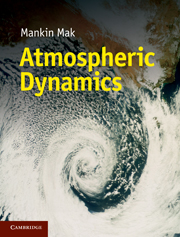Book contents
- Frontmatter
- Contents
- Preface
- 1 Fundamental concepts and physical laws
- 2 Basic approximations and elementary flows
- 3 Vorticity and potential vorticity dynamics
- 4 Friction and boundary layers
- 5 Fundamentals of wave dynamics
- 6 Quasi-geostrophic theory and two-layer model
- 7 Dynamic adjustment
- 8 Instability theories
- 9 Stationary planetary wave dynamics
- 10 Wave-mean flow interaction
- 11 Equilibration dynamics of baroclinic waves
- 12 Nongeostrophic dynamics
- Appendix: Mathematical tools
- References
- Index
- Plate section
3 - Vorticity and potential vorticity dynamics
Published online by Cambridge University Press: 05 June 2012
- Frontmatter
- Contents
- Preface
- 1 Fundamental concepts and physical laws
- 2 Basic approximations and elementary flows
- 3 Vorticity and potential vorticity dynamics
- 4 Friction and boundary layers
- 5 Fundamentals of wave dynamics
- 6 Quasi-geostrophic theory and two-layer model
- 7 Dynamic adjustment
- 8 Instability theories
- 9 Stationary planetary wave dynamics
- 10 Wave-mean flow interaction
- 11 Equilibration dynamics of baroclinic waves
- 12 Nongeostrophic dynamics
- Appendix: Mathematical tools
- References
- Index
- Plate section
Summary
This chapter discusses the fundamental concepts (vorticity, circulation and potential vorticity) used for quantifying the rotational property of a flow and analyzing its evolution. The mathematical and physical characteristics of vorticity and circulation are elaborated in Sections 3.1 through 3.6. Those of potential vorticity are elaborated in Sections 3.8.2, 3.8.4 and 3.8.6. We elaborate on how the various mechanisms could change these different measures of the rotational property. We illustrate circulation with sea-breeze in Section 3.4 and potential vorticity with an eddy-driven jet in Section 3.8.5 and hurricane in Section 3.8.7. The emphasis of most discussions is on large-scale flows. To get a feel for the large-scale potential vorticity in the atmosphere, we show several instantaneous as well as statistical distributions of it in Section 3.8.3. Section 3.9 shows how we can succinctly represent the effects of diabatic heating and friction at the boundaries on the potential vorticity dynamics. It is done with the use of additional notions of generalized potential vorticity and generalized potential vorticity flux.
Vorticity and circulation of a three-dimensional flow
There are two complementary concepts that quantify the rotational property of a flow: vorticity and circulation. Vorticity is a local measure, whereas circulation is a bulk (integral) measure. Each can be defined either in the Lagrangian sense or in the Eulerian sense.
- Type
- Chapter
- Information
- Atmospheric Dynamics , pp. 55 - 87Publisher: Cambridge University PressPrint publication year: 2011



